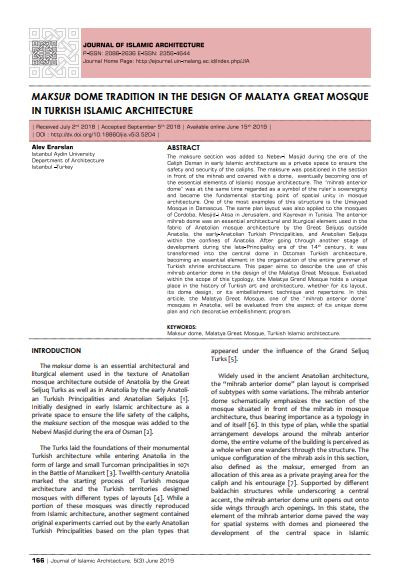
The maksure section was added to Nebev-i Masjid during the era of the Caliph Osman in early Islamic architecture as a private space to ensure the safety and security of the caliphs. The maksure was positioned in the section in front of the mihrab and covered with a dome, eventually becoming one of the essential elements of Islamic mosque architecture. The “mihrab anterior dome” was at the same time regarded as a symbol of the ruler’s sovereignty and became the fundamental starting point of spatial unity in mosque architecture. One of the most examples of this structure is the Umayyad Mosque in Damascus. The same plan layout was also applied to the mosques of Cordoba, Mesjid-i Aksa in Jerusalem, and Kayrevan in Tunisia. The anterior mihrab dome was an essential architectural and liturgical element used in the fabric of Anatolian mosque architecture by the Great Seljuqs outside Anatolia, the early-Anatolian Turkish Principalities, and Anatolian Seljuqs within the confines of Anatolia. After going through another stage of development during the late-Principality era of the 14th century, it was transformed into the central dome in Ottoman Turkish architecture, becoming an essential element in the organization of the entire grammar of Turkish shrine architecture. This paper aims to describe the use of this mihrab anterior dome in the design of the Malatya Great Mosque. Evaluated within the scope of this typology, the Malatya Grand Mosque holds a unique place in the history of Turkish art and architecture, whether for its layout, its dome design, or its embellishment technique and repertoire. In this article, the Malatya Great Mosque, one of the “mihrab anterior dome” mosques in Anatolia, will be evaluated from the aspect of its unique dome plan and rich decorative embellishment program.
I agree to the terms outlined below:
You agree to upload and assign Mosqpedia Database the rights to use the content worldwide and in perpetuity across all current and future media platforms. Mosqpedia Database may edit, copy, adapt and translate your contribution.
The content will be distributed under the Creative Commons Attribution-Deed – Attribution-NonCommercial-NoDerivatives 4.0 International – Creative Commons
All data will be stored in line with data protection regulations.